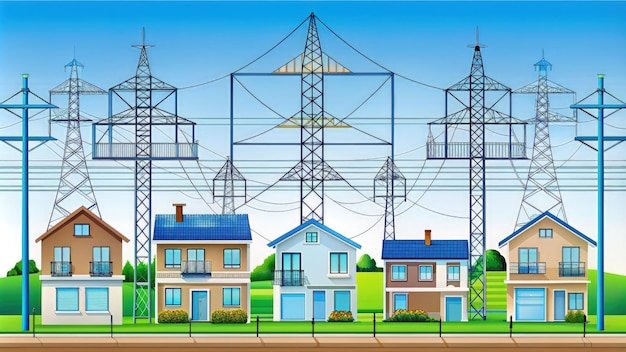
Have you noticed changes in your Pepco electricity bill recently? In fact, the rate has gone up by about 18% for most homeowners since June 2025. So why is that?
Even before June 2025, Pepco electricity bills have been higher than most because Maryland has some of the most expensive electricity prices in the country. The primary reason for this is because the cost for electricity distribution in our region is about 50% of your energy bill. And, since Maryland only produces about 60% of its energy needs, we must rely heavily on imports from other states to meet our growing energy demands. So, coupled with the lack of local energy supply, this greater demand for energy has made the cost of wholesale electricity purchases skyrocket in recent years.
The reason for a lack of local energy supply is primarily due to state government policy, which discourages the production of local, cost-effective fossil fuel energy generation. “Why is that?”, you ask. Well, Maryland has established a policy of support for so-called “green” energy, such as wind and solar, as a way to combat “global warming” on the premise that it is man-made due to excessive emissions of CO2 from gas-powered vehicles and use of coal and natural gas in energy generation.
In Maryland, the ‘green energy’ revolution was set in motion with other nearby states in 2009, to address the so-called “imminent threat” of global warming on all human life on the planet. So, in this existential fight for humanity, Maryland became a member of a “Regional Greenhouse Gas Initiative” (RGGI), a project that issues a penalty carbon tax on all fossil fuel power plants in the state to eventually drive them out of operation. Proceeds from these taxes are then sent to local jurisdictions and community groups to hand out flyers and conduct other such activities to promote the use of “green energy” alternatives. In 2024 alone, these punitive taxes on fossil fuel plants, have amounted to $214.2 million. Consumers make up this lost revenue to the plants with higher electricity bills. And, in recent years, this has also led to the retirement of 5 major Maryland coal plants.
Of course, proponents of “green energy” claim that removing fossil fuel power plants is necessary to save the planet from the threat of “global warming”. But besides that, some even claim that renewable energy, such as solar and wind, is actually less expensive than coal or natural gas. But, is this, in fact, really true? Let’s analyze.
Is green energy more cost-effective than fossil fuel energy?
A recent peer-reviewed study compared the cost of “green” versus “fossil fuel” power generation. The conclusion of this study was that wind and solar are more expensive than fossil fuel in their full system operation. [Energy, Vol. 259 15 November 2022, 124905] https://www.climatedepot.com/2025/03/04/analhysis-yes-coal-natural-gas-remain-much-cheaper-than-wind-solar/ Consider an example of wind and solar power production in Texas, which has the ideal circumstances of windswept plains and sunny skies all day.
“Even in Texas, however, the Energy study shows wind and solar power are prohibitively expensive. The peer-reviewed study shows solar power produced in Texas is more than triple the cost of nuclear power, more than quadruple the cost of coal power, and more than 10 times the cost of natural gas power….By the full-system numbers, solar power in Texas costs $413 per megawatt hour (mwh) of generation. Wind power costs $291 per mwh. Nuclear power costs $122. Coal power costs $90. Natural gas power costs merely $40. That is a huge price differential between wind and solar versus all other energy sources.”
Besides the expensive cost of “green” energy, it also carries with it other negative effects as compared to fossil fuel energy. For example, in operation, solar and wind power is especially unreliable and prone to bring blackouts and brownouts, due to storage limitations and the inherently unstable, variable nature of wind and sun itself. Other negative effects include harm to wildlife, unsightly appearance, and displacement of large tracts of valuable farm land.
What about “global warming”?
Despite its many negative effects, proponents of “green” energy still claim that its main value and purpose is to replace fossil fuel generation so as to reduce the harmful effects of man-made CO2 in the earth’s atmosphere.
While government climate science “experts” have offered lots of models that predict the harmful effects of sea levels rising and other gloomy forecasts due to CO2 emissions from fossil fuel plants, most respected nongovernment experts in the field disagree. For example, the Nongovernmental International Panel on Climate Change (NIPCC) has found that the earth has not warmed significantly for the past two decades and that “there is no close correlation between temperature variation over the past 150 years and human-related CO2 emissions.” Idso, C.D., et all, San Francisco, 2013, Climate Change Reconsidered II: Physical Science. Chicago, IL: The Heartland Institute.
The Real Solution
So, isn’t the real solution to rising electricity bills to increase the supply of cost-effective, in-state power generation, including especially clean coal and natural gas? Long term, more nuclear power is also good, such as currently provided in the single Calvert Cliffs Plant, which provides about 40% of all power generated in the state. Renewable hydroelectric power is also good where available, such as at the Conowingo Dam, which provides about 5% of our state’s energy generation. And, even solar panels for many small, specialized purposes is a useful part of our mix of energy production in the state as well.
However, a logical first step towards a real, long-lasting solution to high energy costs would be to withdraw from the punitive RGGI program to allow fossil fuel plants to provide energy to Maryland consumers in a cost-effective manner. Also, stop state subsidies and mandates that discourage gas-powered vehicles in favor of expensive electric vehicles and their related infrastructure. Happily, some forward-looking, sensible members of the Maryland General Assembly have been working to promote this type of solution for the benefit of all citizens and taxpayers in the state.


This is a well expressed overview of what is right in front of us, that many will attempt to pretend is not real.
So thank you Lee for this effort at a reality sandwich!
Robert Boone
Do you really think there has been a serious spike in man-made CO2 emissions since the 2013 report? In 2020, The international energy agency came out with a study that showed CO2 emissions in 2019 fell by 2.9% compared to 2018. And at that time CO2 emissions were about 15% BELOW 2000 levels, even as the levels continued to rise throughout the rest of the world. Nothing we do in Maryland or the rest of USA to limit man-made emissions is going to clean up the excess emissions coming from factories and power plants in India and China, of course.
In any case, CO2 in the atmosphere is not a pollutant, but natural and necessary for all life. It only comprises about .04% of the atmosphere. And man-made CO2 only comprises about 1/3 of the earth’s CO2, or just over one one-hundredth of one percent of the atmosphere. Throughout the long history of our planet, the amount of CO2 has been many times higher in the past, and yet here we are.